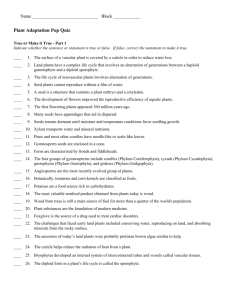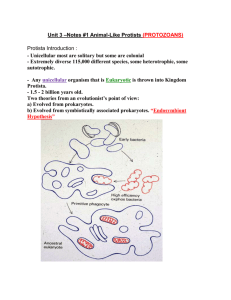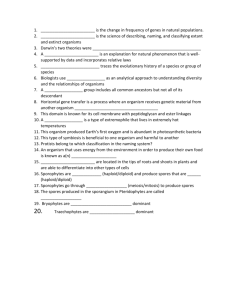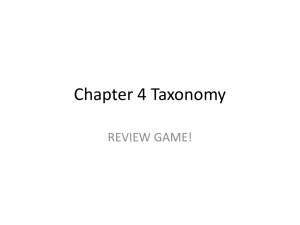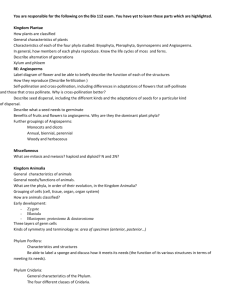SAT Review 5- div of..
advertisement
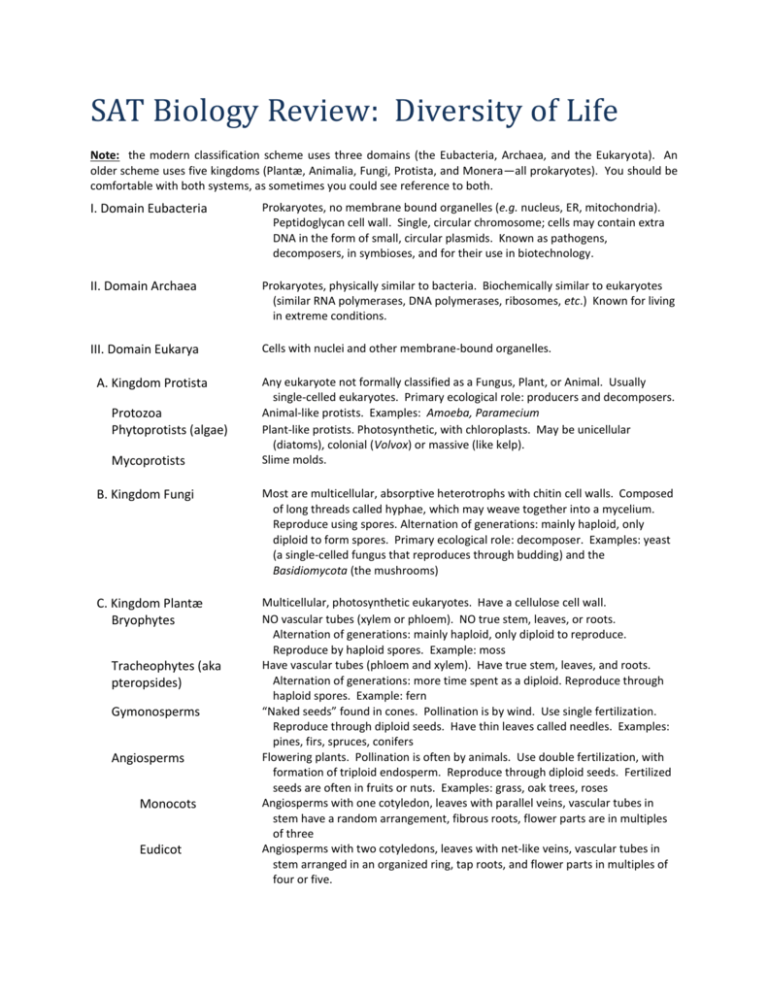
SAT Biology Review: Diversity of Life Note: the modern classification scheme uses three domains (the Eubacteria, Archaea, and the Eukaryota). An older scheme uses five kingdoms (Plantæ, Animalia, Fungi, Protista, and Monera—all prokaryotes). You should be comfortable with both systems, as sometimes you could see reference to both. I. Domain Eubacteria Prokaryotes, no membrane bound organelles (e.g. nucleus, ER, mitochondria). Peptidoglycan cell wall. Single, circular chromosome; cells may contain extra DNA in the form of small, circular plasmids. Known as pathogens, decomposers, in symbioses, and for their use in biotechnology. II. Domain Archaea Prokaryotes, physically similar to bacteria. Biochemically similar to eukaryotes (similar RNA polymerases, DNA polymerases, ribosomes, etc.) Known for living in extreme conditions. III. Domain Eukarya Cells with nuclei and other membrane-bound organelles. A. Kingdom Protista Protozoa Phytoprotists (algae) Mycoprotists Any eukaryote not formally classified as a Fungus, Plant, or Animal. Usually single-celled eukaryotes. Primary ecological role: producers and decomposers. Animal-like protists. Examples: Amoeba, Paramecium Plant-like protists. Photosynthetic, with chloroplasts. May be unicellular (diatoms), colonial (Volvox) or massive (like kelp). Slime molds. B. Kingdom Fungi Most are multicellular, absorptive heterotrophs with chitin cell walls. Composed of long threads called hyphae, which may weave together into a mycelium. Reproduce using spores. Alternation of generations: mainly haploid, only diploid to form spores. Primary ecological role: decomposer. Examples: yeast (a single-celled fungus that reproduces through budding) and the Basidiomycota (the mushrooms) C. Kingdom Plantæ Bryophytes Multicellular, photosynthetic eukaryotes. Have a cellulose cell wall. NO vascular tubes (xylem or phloem). NO true stem, leaves, or roots. Alternation of generations: mainly haploid, only diploid to reproduce. Reproduce by haploid spores. Example: moss Have vascular tubes (phloem and xylem). Have true stem, leaves, and roots. Alternation of generations: more time spent as a diploid. Reproduce through haploid spores. Example: fern “Naked seeds” found in cones. Pollination is by wind. Use single fertilization. Reproduce through diploid seeds. Have thin leaves called needles. Examples: pines, firs, spruces, conifers Flowering plants. Pollination is often by animals. Use double fertilization, with formation of triploid endosperm. Reproduce through diploid seeds. Fertilized seeds are often in fruits or nuts. Examples: grass, oak trees, roses Angiosperms with one cotyledon, leaves with parallel veins, vascular tubes in stem have a random arrangement, fibrous roots, flower parts are in multiples of three Angiosperms with two cotyledons, leaves with net-like veins, vascular tubes in stem arranged in an organized ring, tap roots, and flower parts in multiples of four or five. Tracheophytes (aka pteropsides) Gymonosperms Angiosperms Monocots Eudicot D. Kingdom Animalia Phylum Porifera Phylum Cnidaria Phylum Platyhelminthes Phylum Nematoda Phylum Annelida Phylum Mollusca Phylum Arthropoda Phylum Echinodermata Phylum Chordata Agnathans Chondrichthyes Osteichthyes Amphibians Reptiles Aves Mammals Multicellular, ingestive heterotrophic eukaryotes Sessile (non-moving) adults. Filter-feed through pores. No true tissues. Asymmetrical. Example: sponges Have stinging cells. Only two cell layers (diploblastic). Gastrovascular cavity for digestion. Radial symmetry. Examples: coral, jellyfish, anemone, hydra Flat worms. Acoelomate. Gastrovascular cavity. Bilateral symmetry. Use flame cells to remove waste. Examples: Planaria, tapeworms. Round worms. Pseudocoelomate. One-way digestive tract (intestine). Example: C. elegans Segmented worms. Coelomate. Protostome. Heavily segmented. Use nephridia to remove waste. Example: earthworms, leeches. “Muscular foot”. Coelomate. Protostome. Often have soft bodies with hard shells. Example: snails, clams, octopus, squid “Jointed feet”. Coelomate. Protostome. Chitin exoskeleton. Segmented bodies, with head, thorax, and abdomen. Most diverse animal phylum (has the most characterized species) Examples: crustaceans (crabs, lobsters), insects, arachnids (spiders, scorpions) [SAT questions about the parts of an insect’s body are possible.] “Spiky skin”. Coelomate. Deuterostome. Water vascular system. Adult sea stars often look to have radial symmetry, but are bilateral (they have heads and brains as juveniles). Examples: sea stars (starfish), sea urchins [That sea stars are radial as adults in sometimes used in SAT questions.] Hollow dorsal nerve chord, gill slits, notochord, tail. Coelomate. Deuterostome. No jaw or limbs. Cartilage skeleton. Example: Lampreys 4 limbs. Cartilage skeleton. Examples: Sharks, rays Bony skeleton. Two-chambered heart. Example: Fish Live on land, but need water as juveniles and to reproduce. Breathe through skin. Three-chambered heart. Examples: frogs, salamanders Waterproof keratinized skin, waterproof eggs (amniotic eggs). Lungs. Internal fertilization. Three-chambered heart with a partial septum. Examples: lizards, snakes, turtles. Have feathers. Hard-shelled eggs. Four-chambered heart. Endothermic (warmblooded) Example: birds Have hair, produce milk to feed young. Most carry eggs to term internally (vivipary, or live birth). Four-chambered heart. Endothermic (warm-blooded) Some concepts of note: 1. Prokaryotes v. Eukaryotes. Remember to focus on traits these cells share as well as how they differ. Both have cell (plasma) membranes, cells walls, cytoplasm/cytosol, ribosomes, and DNA/chromosomes. 2. Alternation of generations. Unlike animals, fungi and plants often live part or most of their lives as haploids. The higher up on the evolutionary tree, the more time you spend as diploid. For example, fungi and bryophytes (the most primitive plant) are predominantly haploid, and only become diploid to go through meiosis to produce spores. The ferns (tracheophytes) live as haploid gametophytes, and then combine to produce diploid ferns. The gymno- and angiosperms are diploid, and only live as a haploid when the pollen tube tunnels to the ovule. 3. Animal Tissues. The simplest animals (the porifera) have no true tissues, or groups of cells of similar structure and function that accomplish a distinct task. Cnidarians have two different types of tissues, ectoderm (outer layer) and endoderm (inner layer). All other animals have three different types of tissues, each derived when an embryo gastrulates: endoderm (forms the inside, like digestive systems), mesoderm (forms the middle, like muscle and bone), and ectoderm (forms the outside, like skin, nerves, and hair). 4. 5. 6. 7. Body Cavities. Some of the bilateral animals have hollow body cavities (coeloms) that hold their organs, and others do not. Platyhelminthes are acoelomates, with bodies made of solid tissue with no hollow cavity. Nematodes are pseudocoelomates, a “tube-within-a-tube”, with their intestines floating unsecured in the hollow body cavity. All phyla above nematoda are coelomates, with the internal organs supported in the hollow body cavity (coelom) by layers of mesoderm. Embryo types. The animal phyla annelida, mollusca, and arthropoda are protostomes, and follow a common development pattern as they grow from an embryo. The two most advanced animal phyla— echinodermata and chordate—are deuterostomes. Heart anatomy. Within the chordates, there is a very predictable pattern of heart development. Agnathans, chondrichthyes, and osteichthyes all have two-chambered hearts (one atrium connected to one ventricle) because they breathe through gills. Amphibians developed a three-chambered heart (one atrium collecting deoxygentated blood from the body, one atrium collecting oxygenated blood from the skin, and both emptying into one ventricle). Reptiles have a 3½-chambered heart (a partial septum in the ventricle reduces the mixing of the oxygenated and deoxygenated blood in the ventricle). Aves (birds) and mammals have a four-chambered heart with complete separation of deoxygenated and oxygenated blood into the right and left halves of the heart, respectively. Thermy. Almost all animals are ectotherms, or cold-blooded. Their body temperature equals the temperature of the outside environment. Birds and mammals are endotherms, or warm-blooded, and maintain a constant internal temperature. Figure 1. Organization of the animal phyla.
